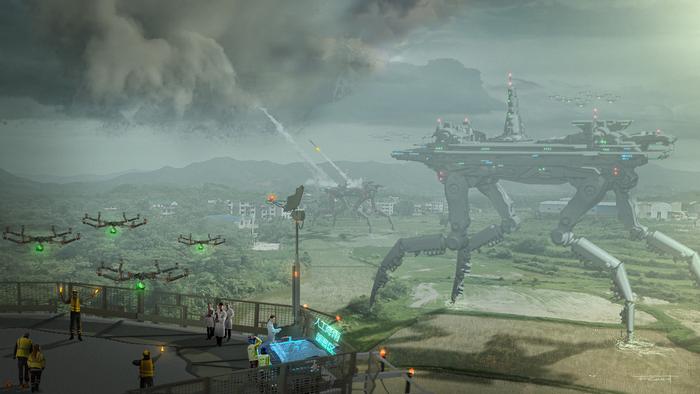Make it snow! Researchers explore sci
Imagine this possibility. In a not too distant future, humans have improved weather modification tools like cloud seeding technology to the point where weather itself is not just predictable, but controllable. In these scenarios, corporations with lax governmental oversight maximize their control over their environment, essentially turning weather itself into a luxury good. Glitzy ski resorts use that control to offer customers snowy vacations year round. Rainfall, once left up to forces of nature, can now be purchased on demand.
Those are just a few of the data informed science fiction scenarios experts drafted as part of a recent paper released in the journal Global Sustainability. The paper, led by Colorado State University Assistant Professor Patrick Keys, asked international experts in global water topics to analyze research he and his team compiled about the ways humans may be impacting atmospheric water cycles today and bring them to life through science fiction narratives and essays. They believe the descriptive, narrative approaches help provide a clearer picture into a too often drowned in data and quantitative literature.
The experts created 10 different scenarios with striking title names like “We are as gods” and “Too much rain in paradise.” In that first example, the authors focused around a speech provided by a future scientist speaking of the hypothetical dangers of weather modification. Another scenario imagines a world where a politician, struggling to maintain an edge during an election season, invokes weather management as a way to garner electoral favor. Other scenarios conjure a future where weather itself is privatized and rainfall can be sold to the highest bidder.
In the privatized rain example, a fictionalized rain provider going by the name “AnyWeather” sends a note to a customer informing them that their request for a “Spring Rains Service” was denied because it conflicts with another, presumably wealthier client who took priority over them. A separate scenario focuses on a fictionalized history podcast which described a strange, off-putting haze appearing over the Lagos, Nigeria skyline. The haze, according to the podcast, was the byproduct of a geoengineering approach called cloud condensation nuclei.
“Stories are everywhere and are an integral part of human life,” Keys said in a statement. “They tell you something different from a graph in a research paper. They allow you to explore how people may feel or react to these kinds of changes.”
Researchers used narratives to bring data to life
Humans are already affecting weather patterns in ways that can be difficult to visualize. Land use, pollution, and climate change, the researchers note, are all affecting where clouds form and the amount of rain that falls. Keys and his fellow researchers combined data gleaned from real journal entries and the speculative curiosity of science fiction to generate a variety of different senators exploring what the world might look like following years of human efforts to modify the atmosphere.
The researchers first gathered text of abstracts from journal articles discussing humans’ effect on water cycles. Ideas from those abstracts were then broken up into themes based on common economic principles. Experts in global water topics were then presented with the themes and instructed to come up with hypothetical scenarios. The narratives varied in format, with some remaining like typical science fiction stories and others coming by way of fictionalized journals and speeches.

Keys then reached out to an artist named Fabio Comi to create illustrations accompanying the stories. In one of the images, an employee at a cloud seeding company near a ski resort appears to take measurements and gather data. Another image shows a four-legged robot the size of skyscrapers walking through a field firing cloud seeding missiles into the sky. An assortment of smaller drones buzz around as scientists observe from a distance. Though evocative, the stories and images aren’t only intended to stir readers’ curiosity. Keys believes their descriptive power could help inform public policy debates.
“These scenarios have an ability to raise interesting questions about policy, regulation and enforcement–what those all may look like,” Keys said. “This approach can also help us recognize some of the aspects we may not be paying attention to and make better sense of it all.”
Cloud seeding and other climate manipulation tactics are already being deployed to promote rainfall and, in some cases, to combat smog. At least eight US states are exploring cloud seeding in particular as a potential tool to respond to years worth of extreme drought. These efforts are still in their early stages though. The data-informed, fictionalized scenarios presented in the Global Sustainabilitypaper offer a glimpse into the notably divergent paths governments and private industry using these tools can take. Each of those scenarios are determined in part by policy decisions and economic frameworks decided many years before the sci-fi tinged senators ever play out.
For now, critics argue relying only on geoengineering tricks to address changing weather platforms remains closer to fiction than science. Cloud seeding currently only provides modest results and is possible only when a specific, narrow set of environmental conditions are met. Continued warming resulting from climate change could risk reducing the odds those conditions will be met. Some scientists have similarly pushed back against other efforts like marine cloud brightening, citing limited research on the technique’s long term limited effects. Even if these measures do prove useful, others warn they still won’t work as a quick-fix substitute for radically reducing greenhouse gas emissions and our reliance on fossil fuels.
本文地址:http://1.zzzogryeb.bond/html/53b899345.html
版权声明
本文仅代表作者观点,不代表本站立场。
本文系作者授权发表,未经许可,不得转载。